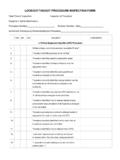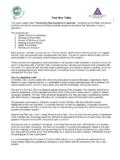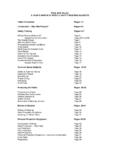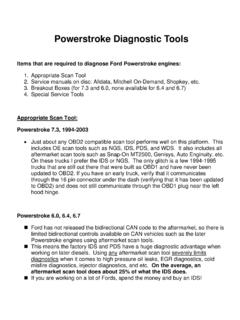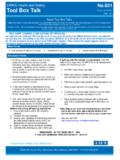Transcription of 104 Standard Tool Box Talks - STEP
1 STEPSTEPSTEPSTEP inginginging toward safety compliance! ** tool Box Talks are a reference tool and should only be used to supplement a well established, comprehensive safety program Developed by STEP, LLC Box 1402, Murray, Kentucky 42071 (270)753-6529 General Industry TBT 1 ABRASIVE BLASTING When performing abrasive blasting operations, from a safety standpoint, there are numerous hazards that must be addressed. First and foremost are respiratory hazards. Dust hazards are created as the abrasive materials and the surface coatings are shattered and pulverized during blasting operations to particles of respirable size. The composition and toxicity of the abrasive as well as the coating must be known to determine the health hazard as well as respiratory selection. The many types of abrasive materials have varying degrees of hazard with silica sand being perhaps the most hazardous mineral abrasive used.
2 Whenever possible, silica sand use should be limited and, if possible, a substitute material used. Other types of abrasives include: synthetic or natural mineral grains; metallic shot or hard grit (made of steel or chilled cast iron); and organic abrasives such as ground corncobs and walnut shells. The hazards of steel or cast iron dust are relatively minimal; however, combustible organic abrasives may be pulverized fine enough to be capable of forming explosive mixtures with air. The coatings that are being blasted may, for example, contain lead (in paints); arsenic (in furnaces); cadmium (plating); and even silica sand (embedded in the surface of castings). These hazards require specific respiratory protection and are serious health hazards. Some specific information regarding abrasive blasting can be found in the OSHA 29 CFR Additionally, each hazard must be dealt with in accordance with specific OSHA standards . In addition to respiratory hazards, the following safety concerns, depending on the job, may need to be addressed: A.
3 Appropriate PPE for eye, hand, skin, foot, head hazards. B. Fall protection. C. Scaffold & ladder safety. D. Release of toxic dust (Environmental (EPA) concern). E. Correct pressure hoses and couplings. F. Securing the work area to deny unauthorized entry. G. Working in a permit-required confined space. H. Hazard communication -- understanding the materials you are working with (lead, arsenic, cadmium, etc.). STEPSTEPSTEPSTEP inginginging toward safety compliance! ** tool Box Talks are a reference tool and should only be used to supplement a well established, comprehensive safety program Developed by STEP, LLC Box 1402, Murray, Kentucky 42071 (270)753-6529 General Industry TBT 2 ACCESS TO SAFETY INFORMATION - EMPLOYEES As an employer, our company will make every effort to ensure that our employees do not work in conditions that are unsanitary, hazardous, or dangerous to their health or safety.
4 To achieve this goal, employees will receive safety training on a continual basis. This scheduled safety meeting is but one example of providing access to safety information. All of our training, whether situational (addressing a specific hazard at a specific time) or formal (addressing a specific topic in its entirety in a structured training format, , hazard communication) will be interactive with ample opportunity for employees to ask safety related questions and provide positive input. The easiest way to address a safety concern is to ask! Never perform any task for which you do not feel fully qualified from a safety standpoint. Ask your supervisor or the safety representative at our company before putting yourself at risk. Regularly check the posted information on the safety and health bulletin board. Posted information -- such as emergency phone numbers -- may be life saving. During formal training, actively participate. If something doesn t make sense, get clarification.
5 All of our formal safety programs provide direction for additional safety information. For example, our Hazard Communication Plan explains, among other things, the types of information found on labels and Material Safety Data Sheets (MSDS s). More importantly, it explains how this information may be used to prevent physical or health hazard exposure. Our program references the appropriate Standard and is readily available for review. Look around almost any company and you will find safety information in abundance: danger, caution, warning signs operator and equipment manuals; ANSI and UL approvals; fire extinguisher inspection records (and gages); control zones; weight, speed, and capacity limits; as well as visual (hand signals) and audible warnings of danger. All the safety information in the world is of no value if it is not internalized and put to use. Whether the information is highly technical or simply a reminder of a hazardous condition, it must be heeded.
6 Employees are expected to actively participate in protecting themselves and their co-workers from injury. Safety standards and procedures do not pop out of the blue -- they were, and are, developed after years of accident analysis by safety experts. There is no point in becoming an accident statistic when safety information is so readily available. Think safety -- act safely! STEPSTEPSTEPSTEP inginginging toward safety compliance! ** tool Box Talks are a reference tool and should only be used to supplement a well established, comprehensive safety program Developed by STEP, LLC Box 1402, Murray, Kentucky 42071 (270)753-6529 General Industry TBT 3 ACCESS TO SAFETY INFORMATION - MANAGEMENT Our company has an obligation to provide a workplace that is inherently safe. Where does safety information come from? Put simply, the safety rules come from the Occupational Safety & Health Administration (OSHA) in the form of standards .
7 As a point of interest, there are some states which have adopted their own standards , however, these standards have to be as stringent as OSHA s and approved by OSHA. There are other agencies that provide safety information and guidance. Probably the three most important, from an occupational standpoint, are the National Institute for Occupational Safety and Health (NIOSH), the Environmental Protection Agency (EPA), and the Centers for Disease Control and Prevention (CDC). Information from all of these agencies is available in larger libraries, in bookstores, and on the Internet. Of course, employees have the same access as employers. We must operate within the framework of OSHA standards and all our safety efforts are geared toward meeting the directive found in section 5(a)(1) of the Occupational Safety and Health Act also know as the General Duty Clause. The employer shall furnish to each of his employees employment and a place of employment which are free from recognized hazards that are causing or are likely to cause death or serious physical harm to his employees.
8 Additionally, the employer shall comply with occupational safety and health standards promulgated under the [OSHA] In addition to the above, and more directly related to our daily operations, safety information comes from within our own organization. Hazard assessment, employee feedback, management participation, program evaluation, accident investigation and review --these are the nuts and bolts of our safety program which allow for adjustment and modification as circumstances and levels of safety commitment change. The ultimate beneficiary of a quality safety program is the employee and it is in the employee s best interest to assist us in determining its safety needs. The employee is in the best position to know if the safety policies, procedures, and training are appropriate, clearly understood, and meaningful. Management must encourage the correct behavior and use consistent discipline if safety procedures are not followed Be actively involved.
9 Safety takes a commitment from both management and employees. Management striving for a safe work place without employee involvement is just as meaningless as employees striving for safe working conditions with management standing on the sidelines. The most vital resource for safety information comes from the individual employee who assesses his own work situation, determines safety shortcomings, seeks resolution, and shares input with management. STEPSTEPSTEPSTEP inginginging toward safety compliance! ** tool Box Talks are a reference tool and should only be used to supplement a well established, comprehensive safety program Developed by STEP, LLC Box 1402, Murray, Kentucky 42071 (270)753-6529 General Industry TBT 4 ACCIDENTAL EXPOSURE TO POISONS A poison can be defined as a chemical substance that causes harm when it comes into contact with living tissue. It is clear from reviewing Material Safety Data Sheets that poisons are found at our company.
10 While you don t think of solvents or gasoline, for example, as poisons, they are if ingested, inhaled, absorbed, or injected into your body in sufficient quantities to cause harm. As a point of interest, even prescribed medical drugs which are designed solely to help living organisms can result in poisoning if misused through improper diagnosis or overdose. Knowing the hazards of the chemical products with which you are working, the location and ready accessibility of MSDS, the signs and symptoms of overexposure, the methods of exposure, and the first aid procedures to be taken if exposure occurs are items that could be of life saving importance. What are common on site chemicals which could cause harm and some of the symptoms of overexposure? Proper use, PPE requirements, and first aid procedures are found on appropriate MSDS. Job site chemical poisons include gases such as carbon monoxide; corrosive acids and alkali used in cleaners and paint removers; arsenic compounds found in paints; bleaches; carbon tetrachloride in degreasers; petroleum distillates such as gasoline and kerosene; turpentine which is found in solvents and cleaning solutions; and xylene and toluene which are also found in solvents and degreasers.
